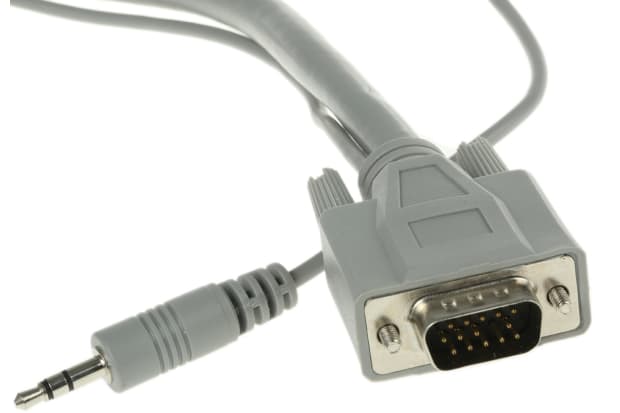- Published 10 Feb 2023
- Last Modified 17 Oct 2024
- 9 min
Everything You Need to Know About VGA Cables

This comprehensive guide provides an in-depth look at VGA cables, covering their types, uses, connector genders, and popular brands in the market. It offers valuable information for buyers, including an introduction to VGA technology, explanations of different cable types and adapters, and answers to frequently asked questions, helping you make an informed decision when purchasing VGA cables.
What is a VGA Cable?
VGA (Video Graphics Array) cables have been used in electronic connectivity since the end of the 80s. These 15-pin VGA cables have lasted through the years, from which they have become a standard in universal video signal transmission to various devices. "VGA" as a term has surpassed its initial significance and now incorporates the different types of cables and connectors with the same pin design and socket format.
The technology of VGA cables can be seen in residential as well as professional environments. In the typical desktop PC setup, these cables form a crucial link between computers and monitors, enabling data visually moved between devices. Their adaptability goes beyond just connecting computers to monitors. They also have a vital role in joining such a wide range of video output devices like laptops and video cards to projectors and specific set-top boxes with a number of display peripherals such as TVs, monitors, and all-in-one PCs.
Notwithstanding the appearance of newer technologies, VGA cables still play a leading role in establishing stable communication between visual and graphic devices in homes and businesses. They engross the link between computers, monitors, projectors, and high-definition television sets, making sure the presence of seamless visual communication. It is worth noting that while the complete VGA ports generally exist in larger devices, small mini-VGA ports are often the choice for portable laptops. These smaller versions which are of different sizes also perform as an intermediary for graphic signal transfer.
This guide was created to analyse different types of VGA cables and explain their general scope with all necessary details. We'll also answer some frequently asked questions about VGA technology, such as, for example, how to recognize VGA port symbols and VGA versus HDMI. When you finish reading this guide, you will get a complete and precise knowledge of VGA technology and will understand its software development with current techniques.
What Does a VGA Cable Do?
VGA cables, first introduced in 1987, quickly became a standard for computer cabling assemblies through various minor revisions and iterations by manufacturers. Today, VGA sockets and cables are still widely used in many PCs, laptops, TVs, and monitors. The most recognisable part of a VGA cable is the classic three-row, 15-pin connector, designated DE-15 and commonly referred to as D-sub miniature or D-sub.
These connectors can be either male or female and are often flanked by a pair of captive thumb screws. These screws can be tightened after insertion to create a more secure connection with the socket, typically found on monitor VGA input sockets, laptop VGA input ports, or similar applications such as TV ports.

VGA cables are designed to carry an analog video signal between various types of electrical devices and components. Each of the VGA connector’s socket pins plays a role in transferring and displaying some aspect of an RGBHV video signal. In this context, RGBHV stands for red, green, blue, horizontal sync, and vertical sync. When output by a PC, laptop, or video/graphics card, these elements combine to form a cohesive video signal that is viewable on a monitor or other device screen at the other end of the VGA cable.
VGA cables have numerous unique features that make them especially well-suited for their job. They support multiple scan rates, making them compatible with various monitors through multisync capability. Additionally, VGA connectors include VESA DDC pins for identifying attached display devices, allowing for hot-swapping capabilities.
In the sections that follow, we will outline some of the different types of VGA cables and look at a range of other important properties, variables, and accessories. We will briefly cover key elements of VGA cable buying, such as gendered connectors or VGA adapters/splitters, and identify some of the market-leading brands known for high-quality VGA cables and components.
VGA Cable Types
Despite being an older connection standard, VGA (Video Graphics Array) cables remain prevalent in modern technology. Their continued relevance is evident in the wide array of VGA ports found on contemporary computers, monitors, laptops, TVs, graphics cards, and various video-related peripherals.
The VGA cable market offers a rich variety of options, including standard VGA and SVGA (Super VGA) cables, as well as numerous adapters, splitters, and compatible accessories. When selecting a VGA cable, it's crucial to understand the distinction between VGA and SVGA:
VGA Cables
These carry analog video signals and typically support resolutions up to 640 x 480. VGA cables are the foundation of this technology, offering reliable performance for basic video transmission needs.
SVGA Cables
Also known as enhanced or ultra VGA, SVGA cables carry analog video signals but support higher resolutions, generally up to 800 x 600. They provide improved image quality for more demanding applications.
VGA Connector Genders
VGA connectors are gendered and come in both male (pins/plug) and female (holes/socket) variants. VGA cables are often identified by the gender of their connectors, such as male-to-male or male-to-female configurations. This identification helps ensure you select the correct cable for your specific connection needs.
Depending on the type of cable and the configuration required at the PC or monitor end, you may need various VGA adapters, extenders, and splitters to create a working connection. Common adapter and splitter options for gendered VGA cables include:
- VGA male to male adapter
- Male to female VGA adapter
- Female to male VGA adapter
- Female to female VGA adapter
VGA Connector and VGA Adapter Types
A wide range of VGA connector types is available today, reflecting the diversity of devices that still use this connection type. VGA connectors are often used alongside newer standards such as DVI connectors and HDMI cables.
The terminology for VGA connectors can be somewhat interchangeable and vague, but the basic or standard VGA connector type is usually referred to by several names, including DE-15, HD15, VGA plug, SVGA plug, D-Sub 15, D-Subminiature, or RGB connector. In addition to the standard D-sub connector type at one end of a VGA cable, various other types of adapters or connectors are available at the opposite end.

Common configurations of VGA cable connectors and adapter ends include:
- D-Sub HD15 VGA
- SVGA HD15
- VGA to HDMI Cable
- VGA to DVI-D
- VGA to DVI or DVI-I
- VGA Male to Female
- VGA Female to Male
- USB to VGA
- VGA to Mini-Jack
- VGA to Phono
These configurations and adapters allow VGA cables to be used in a wide range of setups, ensuring compatibility with both legacy and modern devices.
Popular VGA Cable Brands
There are a huge number of companies worldwide that manufacture VGA cable, although differences can be noticed as a result of the varying construction methods and materials that are used. If in doubt, it’s always best to opt for a reliable cable from a well-known manufacturer as opposed to an option which may be cheaper but is likely also worse quality.
Among the various market-leading suppliers of branded VGA cable, some key names to look out for include the following: